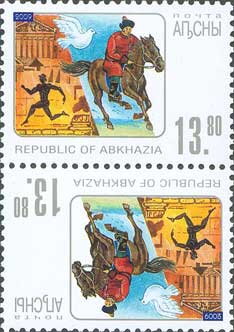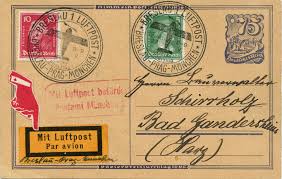Tete-Beche: History of post (Abkhazia 2010)
History of post (Abkhazia 2010)
15 January (Abkhazia ) within release Definitive Issue (10th Issue) goes into circulation Tete-Beche History of post face value 2*13.80 Russian ruble
| Tete-Beche History of post in catalogues | |
|---|---|
| Michel: | Mi: AB 933ST |
Tete-Beche is vertical format.
Issued in sheet of 16 stamps (4x4).Also in the issue Definitive Issue (10th Issue):
- Tete-Beche - Fauna of Black sea face value 2*19;
- Tete-Beche - Fauna of Black sea face value 2*48.90;
- Tete-Beche - Flag of Abkhazia face value 2*6.60;
- Tete-Beche - Flag of Abkhazia face value 2*64.90;
- Tete-Beche - History of post face value 2*13.80;
- Tete-Beche - History of post face value 2*27.60;
- Tete-Beche - Map of Abkhazia face value 2*1;
- Tete-Beche - Modern and ancient ship face value 2*12.90;
- Tete-Beche - Modern and ancient ship face value 2*25.90;
- Tete-Beche - Modern communication face value 2*19.30;
- Tete-Beche - Modern communication face value 2*53.80;
- Tete-Beche - Modern transport face value 2*16.10;
- Tete-Beche - Modern transport face value 2*41.40;
- Tete-Beche - Nature of Abkhazia face value 2*9;
- Tete-Beche - Nature of Abkhazia face value 2*22.50;
- Tete-Beche - Space projects face value 2*18;
- Tete-Beche - Space projects face value 2*46;
- Tete-Beche - Wine, Grapes and Bee on a Flower face value 2*12.10;
- Tete-Beche - Wine, Grapes and Bee on a Flower face value 2*24.15;
Tete-Beche History of post it reflects the thematic directions:
Animals are multicellular, eukaryotic organisms of the kingdom Animalia (also called Metazoa). All animals are motile, meaning they can move spontaneously and independently, at some point in their lives. Their body plan eventually becomes fixed as they develop, although some undergo a process of metamorphosis later on in their lives. All animals are heterotrophs: they must ingest other organisms or their products for sustenance.
The horse (Equus ferus caballus) is one of two extant subspecies of Equus ferus. It is an odd-toed ungulate mammal belonging to the taxonomic family Equidae. The horse has evolved over the past 45 to 55 million years from a small multi-toed creature, Eohippus, into the large, single-toed animal of today. Humans began to domesticate horses around 4000 BC, and their domestication is believed to have been widespread by 3000 BC. Horses in the subspecies caballus are domesticated, although some domesticated populations live in the wild as feral horses. These feral populations are not true wild horses, as this term is used to describe horses that have never been domesticated, such as the endangered Przewalski's horse, a separate subspecies, and the only remaining true wild horse. There is an extensive, specialized vocabulary used to describe equine-related concepts, covering everything from anatomy to life stages, size, colors, markings, breeds, locomotion, and behavior.
Postal history is the study of postal systems and how they operate and, or, the study of the use of postage stamps and covers and associated postal artifacts illustrating historical episodes in the development of postal systems. The term is attributed to Robson Lowe, a professional philatelist, stamp dealer and stamp auctioneer, who made the first organised study of the subject in the 1930s and described philatelists as "students of science", but postal historians as "students of humanity". More precisely, philatelists describe postal history as the study of rates, routes, markings, and means (of transport).



